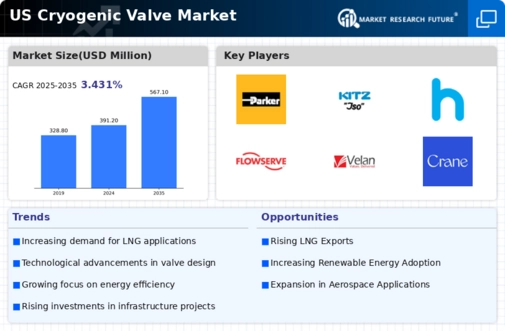Expansion of Industrial Applications
The cryogenic valve market is experiencing growth due to the expansion of industrial applications across various sectors. Industries such as aerospace, pharmaceuticals, and food processing increasingly rely on cryogenic technology for efficient operations. For instance, the aerospace sector utilizes cryogenic valves in rocket propulsion systems, while the pharmaceutical industry employs them for the storage and transport of temperature-sensitive materials. The market for cryogenic valves in these applications is projected to grow at a CAGR of 10% over the next five years. This diversification of applications indicates a robust demand for cryogenic valves, positioning the cryogenic valve market for sustained growth as industries seek reliable solutions for handling cryogenic fluids.
Rising Focus on Safety and Efficiency
The cryogenic valve market is influenced by the rising focus on safety and efficiency in industrial operations. Companies are increasingly prioritizing the implementation of safety measures to prevent accidents associated with cryogenic fluids. This trend is reflected in the adoption of advanced cryogenic valves that offer enhanced safety features, such as automatic shut-off mechanisms and improved sealing technologies. The market is expected to see a growth rate of 12% as industries seek to comply with stringent safety regulations. The cryogenic valve market is likely to thrive as manufacturers innovate to meet these safety demands, ensuring that their products align with the evolving regulatory landscape.
Increasing Adoption of Renewable Energy
The shift towards renewable energy sources in the US is driving the cryogenic valve market. As the energy sector increasingly incorporates liquefied natural gas (LNG) and hydrogen, the demand for efficient cryogenic valves rises. These valves are essential for managing the flow of cryogenic fluids, which are critical in energy production and storage. The US government has set ambitious targets for reducing carbon emissions, which may lead to a projected growth of 15% in the renewable energy sector by 2030. This transition necessitates advanced cryogenic systems, thereby enhancing the market for cryogenic valves. The cryogenic valve market is likely to benefit from this trend as more companies invest in infrastructure to support renewable energy initiatives.
Investment in Infrastructure Development
Investment in infrastructure development in the US is a significant driver for the cryogenic valve market. The government and private sector are allocating substantial funds towards upgrading and expanding existing facilities, particularly in the energy and transportation sectors. For example, the US Department of Energy has announced funding of over $1 billion for projects aimed at enhancing LNG infrastructure. This investment is expected to create a favorable environment for the cryogenic valve market, as new facilities will require advanced cryogenic systems. The anticipated growth in infrastructure projects may lead to an increase in demand for cryogenic valves, as they are integral to the safe and efficient operation of these systems.
Technological Innovations in Valve Design
Technological innovations in valve design are propelling the cryogenic valve market forward. Advances in materials science and engineering have led to the development of more durable and efficient cryogenic valves. These innovations include the use of lightweight materials that can withstand extreme temperatures and pressures, thereby enhancing performance and reliability. The market is projected to grow by 8% annually as manufacturers invest in research and development to create cutting-edge valve solutions. The cryogenic valve market stands to gain from these technological advancements, as they enable companies to offer superior products that meet the increasing demands of various applications.
























Leave a Comment